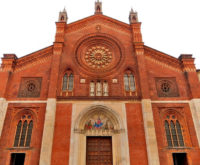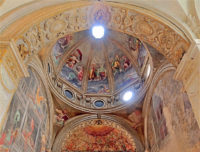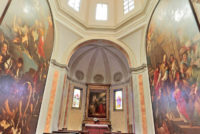The Church of San Marco was founded in the 13th century by the Dominican Order, an influential Catholic religious order that played a significant role in shaping the history of Milan. The church was built as a spiritual center for the Dominicans and has since been an important site for religious and cultural events in the city.
Architectural Features
- Romanesque Architecture: The church’s initial construction features a Romanesque architectural style, characterized by its round arches, thick walls, and sturdy pillars. This sturdy foundation has allowed the church to withstand the test of time and numerous renovations.
- Gothic Additions: In the 14th century, Gothic elements were added to the church’s design. These additions include the pointed arches, ribbed vaults, and flying buttresses that give the church a sense of verticality and elegance.
- Renaissance Elements: During the Renaissance period, the church underwent further modifications, including the addition of frescoes, ornate stonework, and decorative elements that exemplify the artistic sensibilities of the time.
Inside San Marco Church
The Nave: As you enter the church, you’ll be greeted by the impressive nave, a long central aisle flanked by rows of sturdy columns. The nave’s high ceiling features beautiful frescoes, and the large stained-glass windows allow natural light to filter in, creating a serene atmosphere.
St. Augustine’s Chapel: One of the most important chapels within San Marco is St. Augustine’s Chapel, dedicated to the revered theologian and philosopher. The chapel features impressive frescoes and artwork that depict scenes from
St. Augustine’s life, as well as his teachings and writings. These works of art beautifully showcase the influence and importance of St. Augustine’s contributions to Christianity.
St. Dominic’s Chapel: Another noteworthy chapel is St. Dominic’s Chapel, which is dedicated to the founder of the Dominican Order. The chapel is adorned with stunning frescoes illustrating the life of St. Dominic, as well as his pivotal role in establishing the order and its impact on the Catholic Church.
St. Thomas Aquinas Chapel: The St. Thomas Aquinas Chapel pays homage to the influential philosopher and theologian. The chapel features striking artwork that portrays the saint’s life, his works, and the profound influence he had on the development of Christian thought during the Middle Ages.
The Artwork
The Church of San Marco is home to an incredible collection of artwork, including frescoes, sculptures, and paintings by renowned artists such as Bernardino Luini, Vincenzo Foppa, and Tiziano Vecellio (Titian). These works of art contribute to the rich cultural and religious significance of the church, making it a must-see destination for art enthusiasts and history buffs alike.
How to Visit San Marco
The Church of San Marco is open to visitors daily, with the exception of certain religious holidays. The typical opening hours are from 8:00 am to 12:00 pm and from 3:00 pm to 7:00 pm, but it’s always a good idea to check the church’s website or contact them for the most up-to-date information.
To make the most of your visit to San Marco, consider joining a guided tour. Knowledgeable guides will provide you with a wealth of information about the church’s history, architecture, and artwork, enhancing your appreciation for this incredible site. Guided tours can be booked through various tour operators or directly at the church.
Nearby Attractions
While visiting the Church of San Marco, be sure to explore the surrounding area, which is rich in history, culture, and beauty. Nearby attractions include Sforza Castle, the Church of Santa Maria delle Grazie (home to Leonardo da Vinci’s Last Supper), and the beautiful Brera district, known for its picturesque streets, charming cafes, and art galleries.
The Church of San Marco in Milan is a remarkable destination that offers a fascinating glimpse into the city’s rich history, architectural evolution, and artistic heritage. From its Romanesque beginnings to its Gothic and Renaissance additions, the church stands as a testament to the diverse influences that have shaped Milan’s identity over the centuries. Whether you’re an art enthusiast, history buff, or simply seeking a peaceful sanctuary amid the city’s bustle, San Marco is a must-visit destination.
































